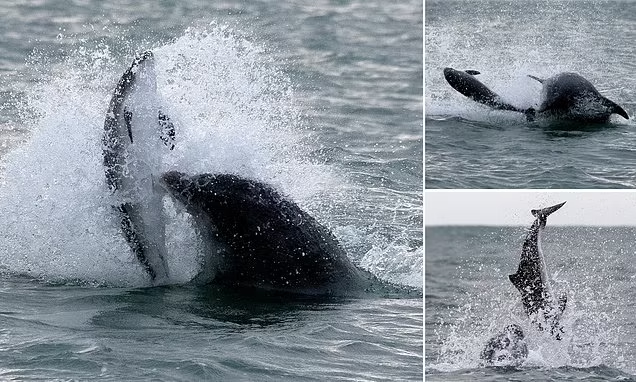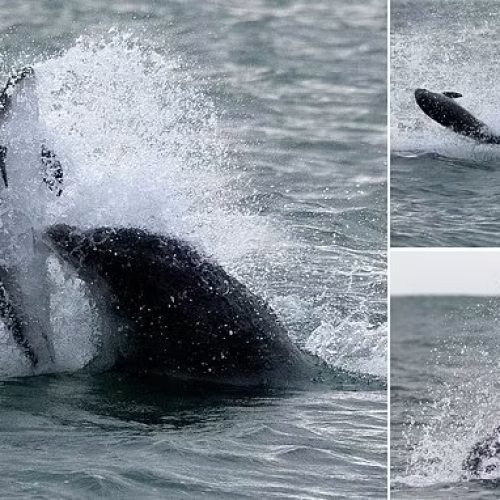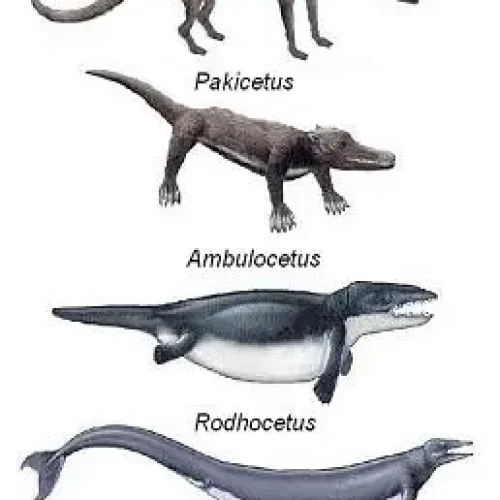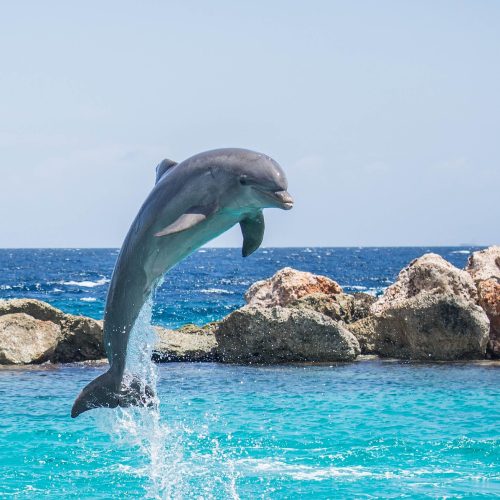Did you know that dolphins, like humans, have distinct physical and behavioral differences between males and females?
Although they may appear similar at first glance, there are several subtle clues that allow experts to determine a dolphin’s sex.
From the size and shape of the dorsal fin to complex social structures, let’s dive together into the fascinating world of differences between male and female dolphins.
In this article
PHYSICAL DIFFERENCES BETWEEN MALE AND FEMALE DOLPHINS
Male and female dolphins have several physical differences that allow them to be distinguished quite easily by a discerning eye. First, males are generally larger and heavier than females.
In the case of the Bottlenose dolphin (Tursiops truncatus), the most common species on French coasts, males measure on average between 2.5 and 3.5 meters and weigh up to 500 kg, compared to 2 to 3 meters and 200 to 300 kg for females.
The shape and size of the dorsal fin are another indicator. That of males is larger, more curved, and more pointed, while that of females is smaller and more rounded. This difference is particularly pronounced in adults.
Finally, genital differences are obviously the most reliable criterion. Males have a genital slit and two mammary slits, while females have only one genital slit flanked by two mammary slits on each side.
Sexing can be done visually when the dolphin swims on its back.
YOU MAY ALSO LIKE – What is a female dolphin called?
BEHAVIORAL DIFFERENCES BETWEEN MALE AND FEMALE DOLPHINS
Beyond physical differences, males and females also exhibit behavioral peculiarities related to their complex social organization.
Males often associate in alliances of 2 to 4 individuals, sometimes even more, to defend territory, access females, and protect each other.
These coalitions can last for many years. In contrast, females tend to live in groups centered around themselves and their offspring, with strong bonds between relatives.
Sexual behavior also differs. Males compete and can be aggressive towards each other to access females. They display, chase, grasp, and strike each other.
Some may even abduct a female and hold her captive. Females are more selective and only mate with certain males. They give signals of receptivity such as leaps, rolls, and contacts.
Studies conducted on wild Bottlenose dolphins in Australia have shown that males sometimes use sponges as tools, placing them on their rostrum to probe the seabed, a behavior never observed in females.
Another study on a population of Bottlenose dolphins in Florida revealed that males spent more time socializing, while females spent more time caring for their offspring and hunting.
Thus, by combining the observation of morphological and behavioral criteria, it is entirely possible to determine whether a dolphin is male or female, whether during sea surveys or examinations of stranded specimens.
This knowledge is essential for better understanding the biology and ecology of these fascinating marine mammals.
YOU MAY ALSO LIKE – Size, shape, fins: the 5 major anatomical differences between dolphins and whales
IDENTIFYING GENDER THROUGH OBSERVATION
Spotting physical characteristics in the wild can be a challenging task when it comes to determining the gender of dolphins.
The underwater environment presents various obstacles, such as limited visibility, quick movements, and the dolphins’ streamlined bodies that conceal external genitalia. Keen observation skills and patience are essential for gender identification in their natural habitat.
To increase the chances of accurately identifying a dolphin’s gender, observers should focus on specific physical features:
– Size: In many dolphin species, males tend to be slightly larger than females.
– Dorsal fin: Male dolphins often have taller, more triangular dorsal fins compared to females.
– Genital slits: Located on the underside of the dolphin’s body, the distance between the genital slit and the anus can indicate gender. In males, the distance is typically greater than in females.
Challenges of underwater observation include the dolphins’ swift movements, murky water conditions, and the brief moments they spend at the surface.
To overcome these difficulties, observers should use high-quality binoculars or telescopes and position themselves strategically to maximize the chances of spotting key physical characteristics.
In captivity, gender identification is more straightforward due to controlled environments and trained animals. Dolphin trainers and veterinarians can closely examine the animals during medical check-ups or training sessions.
Veterinary examinations and records provide accurate information about each dolphin’s gender, health status, and reproductive history.
YOU MAY ALSO LIKE – How intelligent are dolphins?
IMPORTANCE OF UNDERSTANDING DOLPHIN GENDER
Understanding the gender of dolphins is crucial for scientific research and conservation efforts. Population studies rely on accurate gender identification to assess the demographics, sex ratios, and social structures of dolphin populations in the wild.
This information helps researchers monitor the health and stability of dolphin communities and develop effective conservation strategies.
Knowing a dolphin’s gender is also essential for studying their reproductive biology and behavior. Researchers can observe mating patterns, courtship rituals, and parental care among identified individuals.
This knowledge contributes to our understanding of dolphin social dynamics, breeding cycles, and the factors influencing their reproductive success.
In addition to scientific research, understanding dolphin gender enhances public knowledge and appreciation for these fascinating marine mammals.
Educational programs and exhibits in aquariums and marine parks can highlight the differences between male and female dolphins, their unique characteristics, and the importance of gender diversity in maintaining healthy populations.
By promoting responsible wildlife tourism and raising awareness about dolphin conservation, we can foster a deeper connection between humans and these intelligent creatures. Informed tourists are more likely to support sustainable tourism practices and contribute to the protection of dolphin habitats worldwide.








